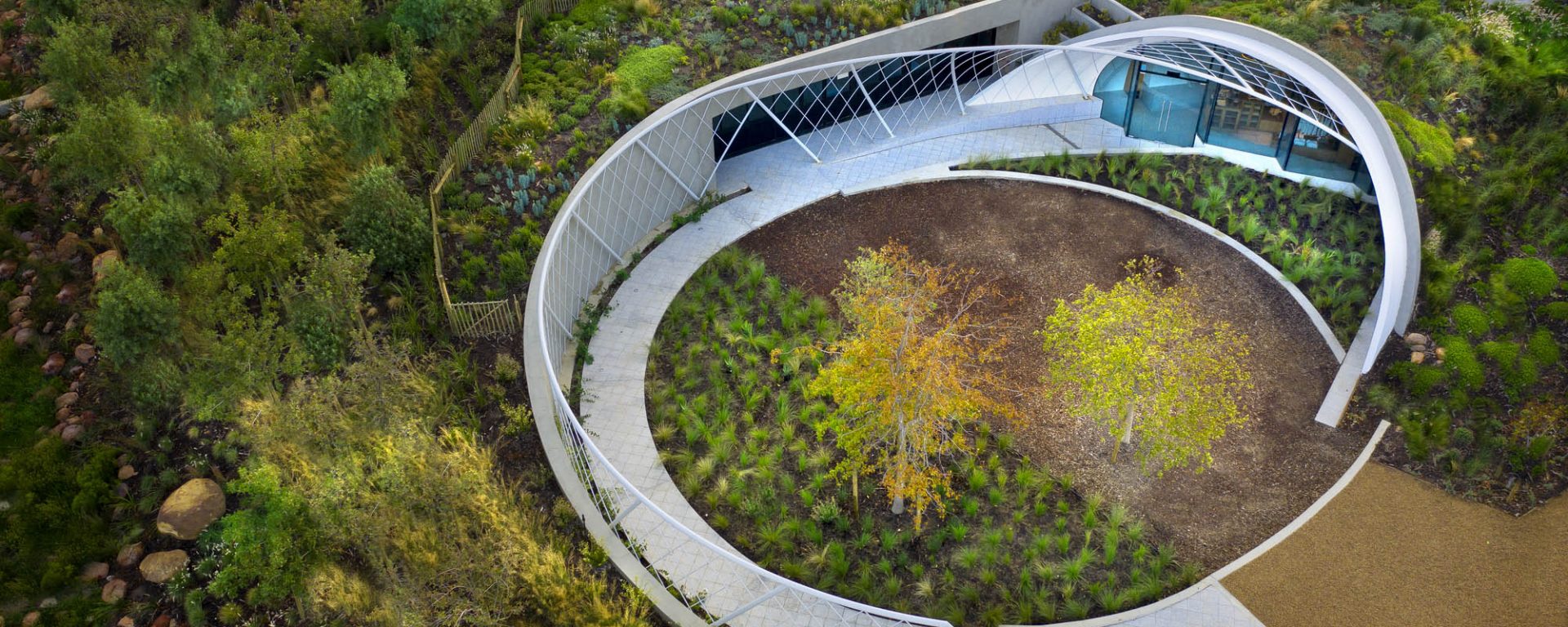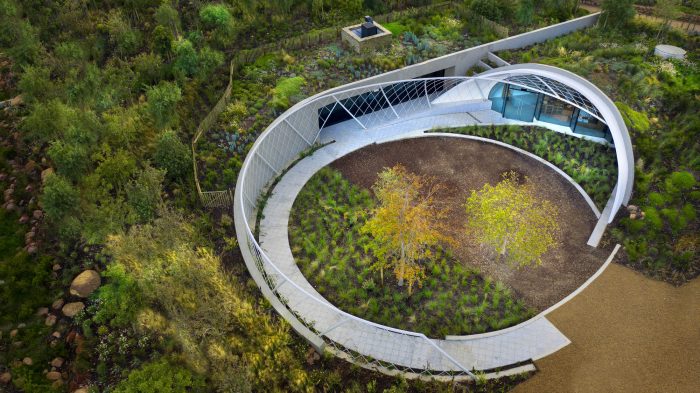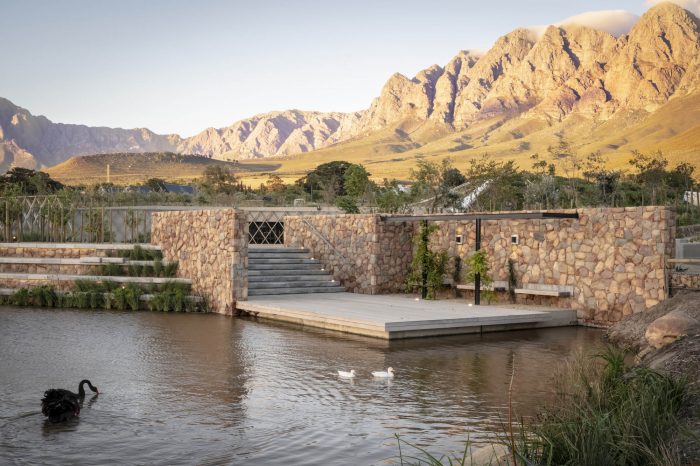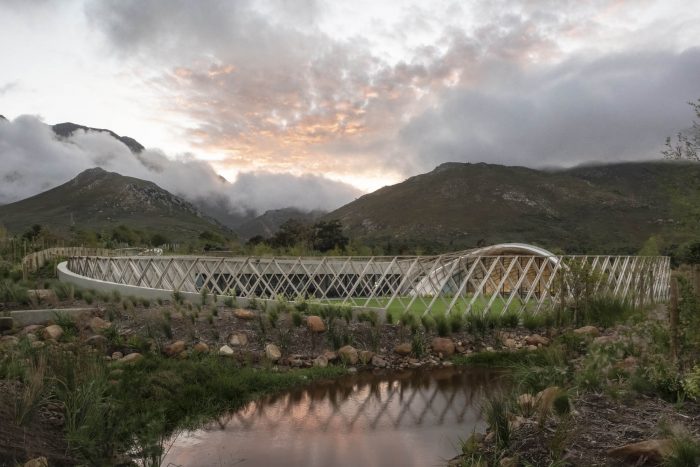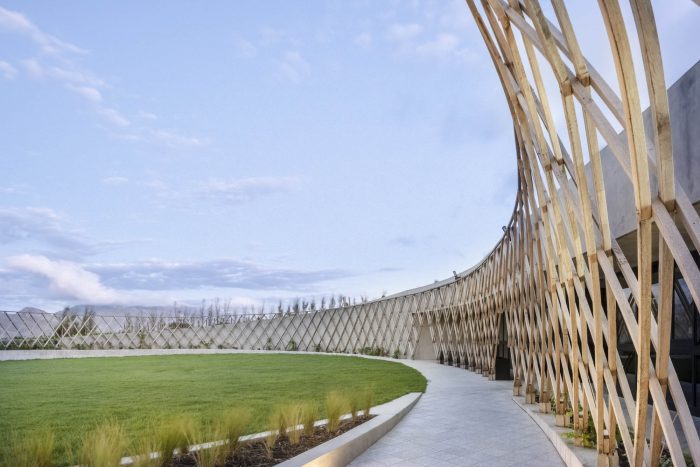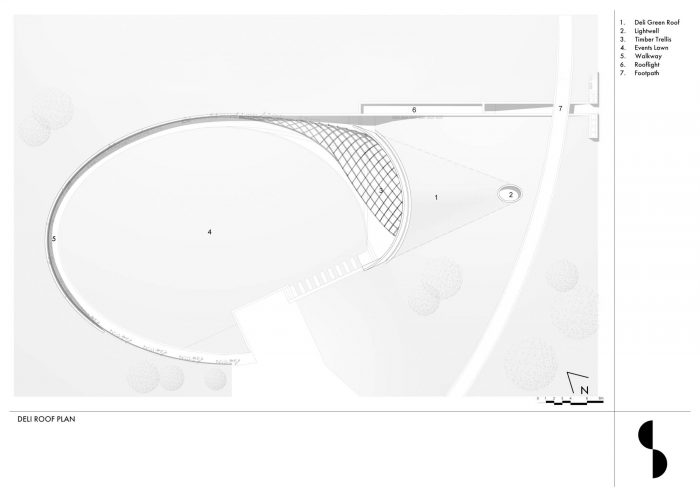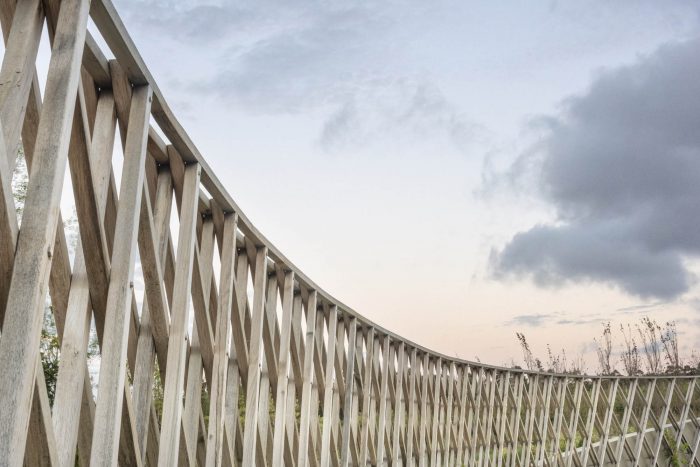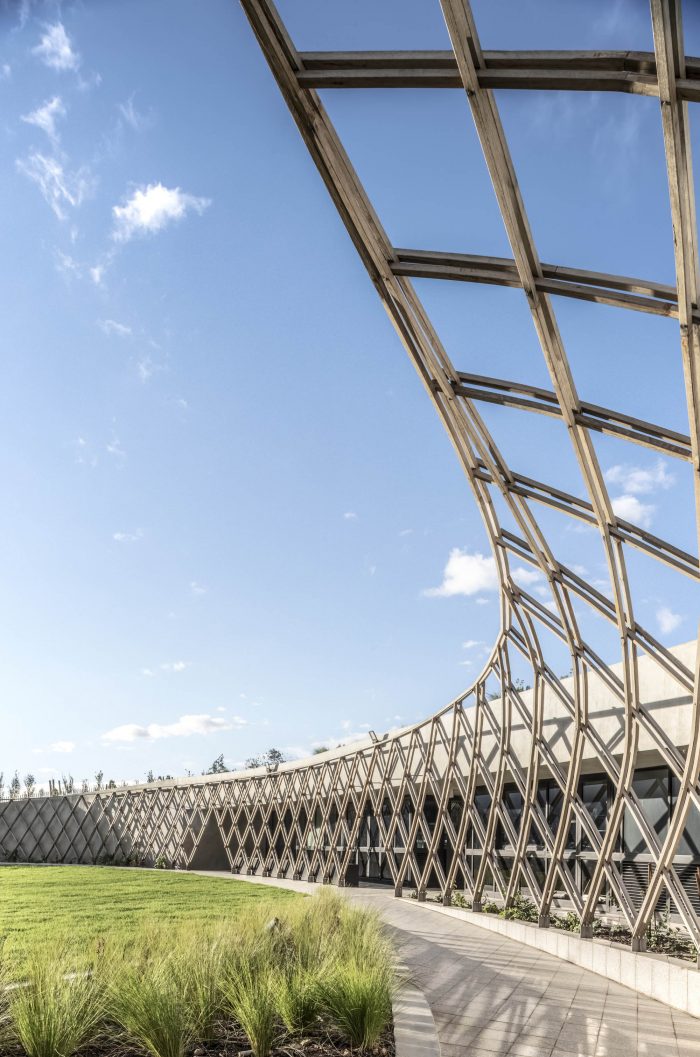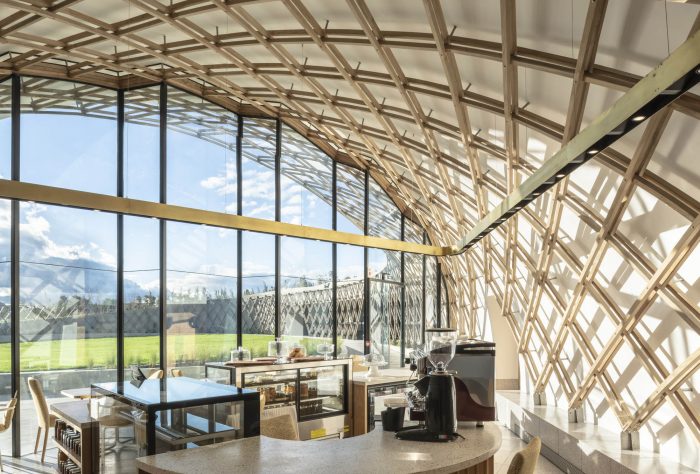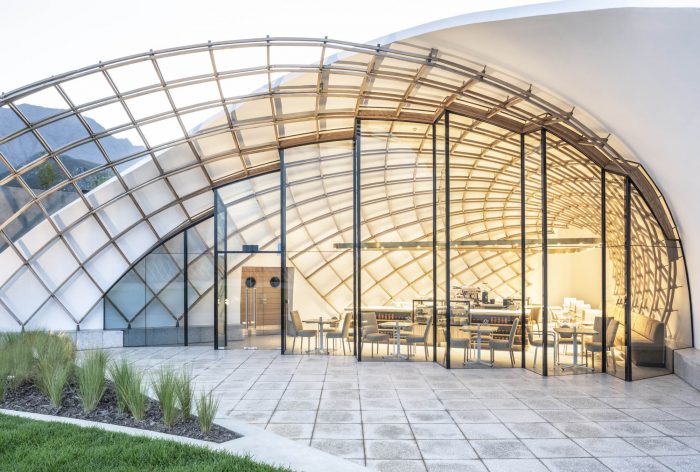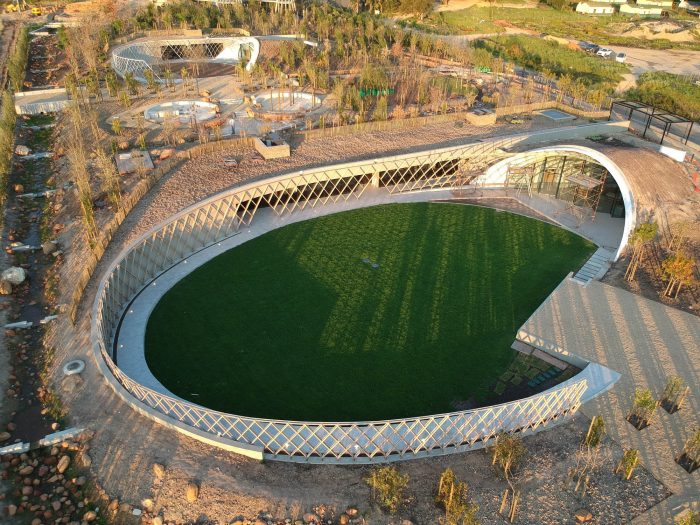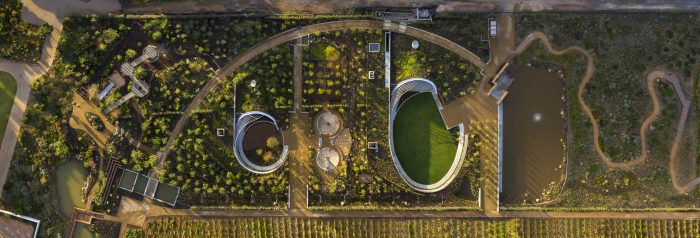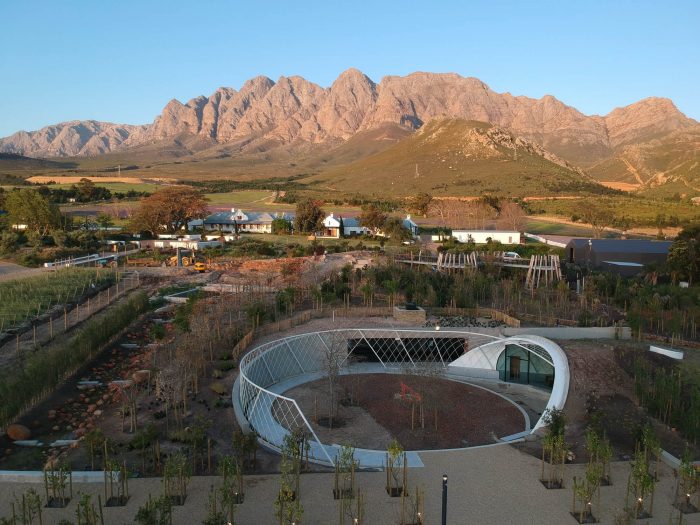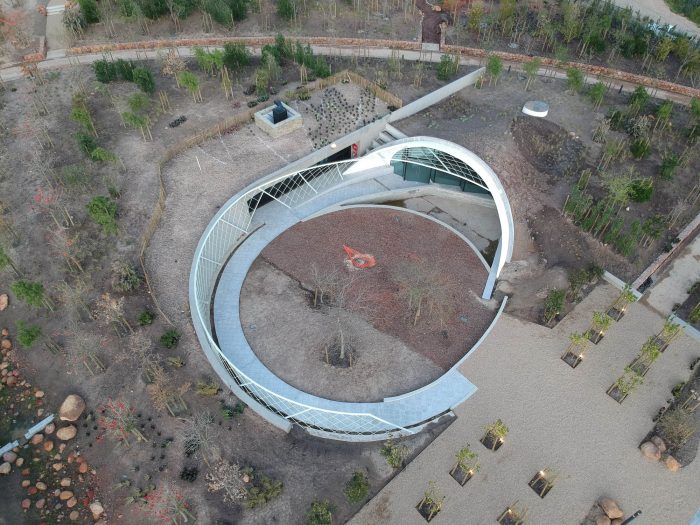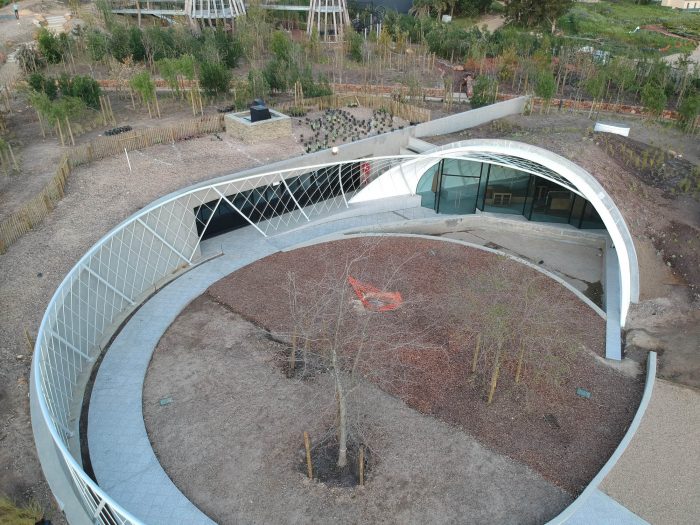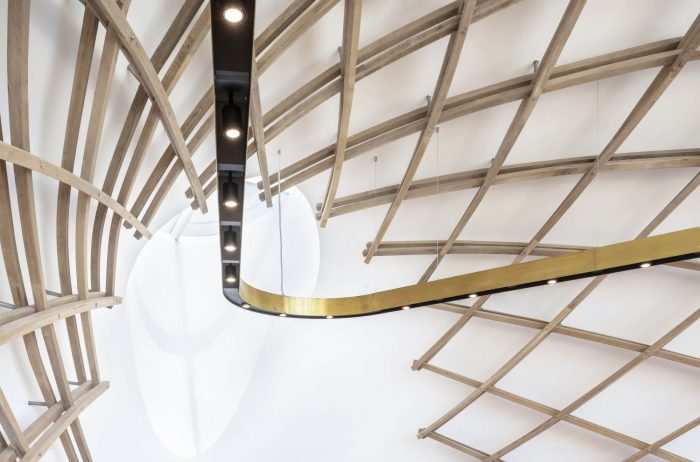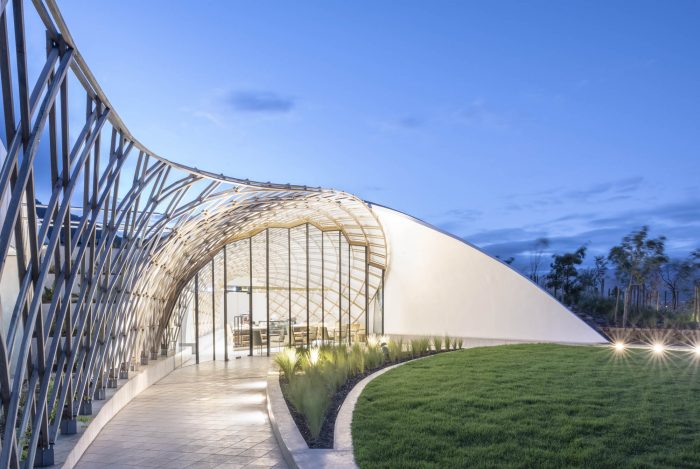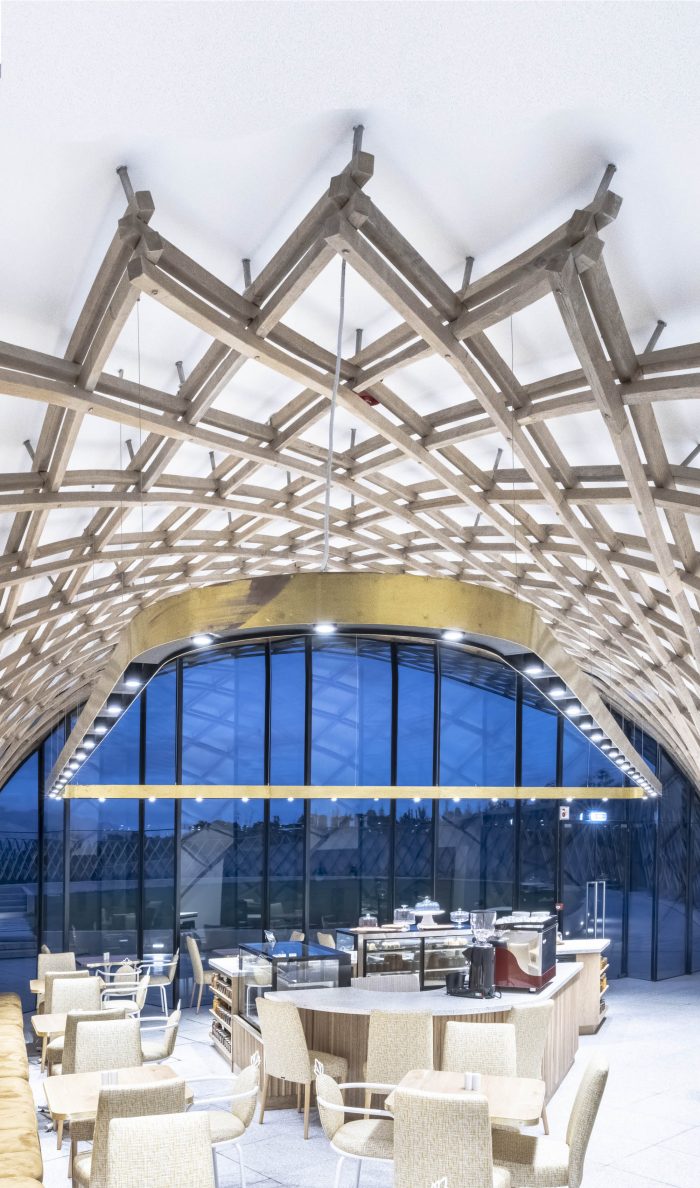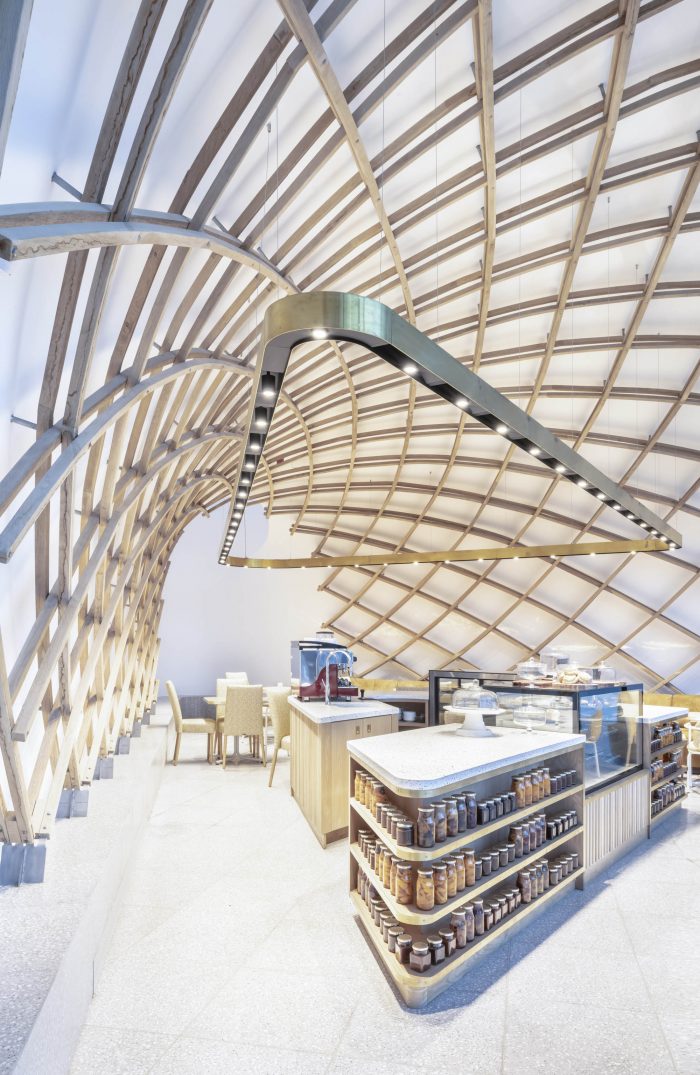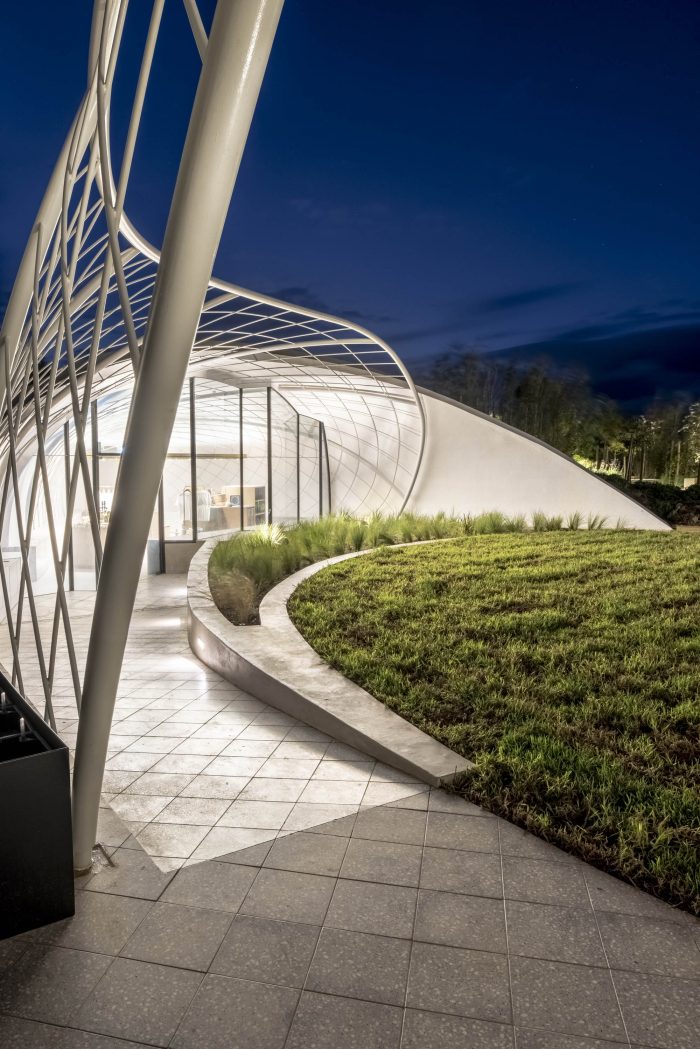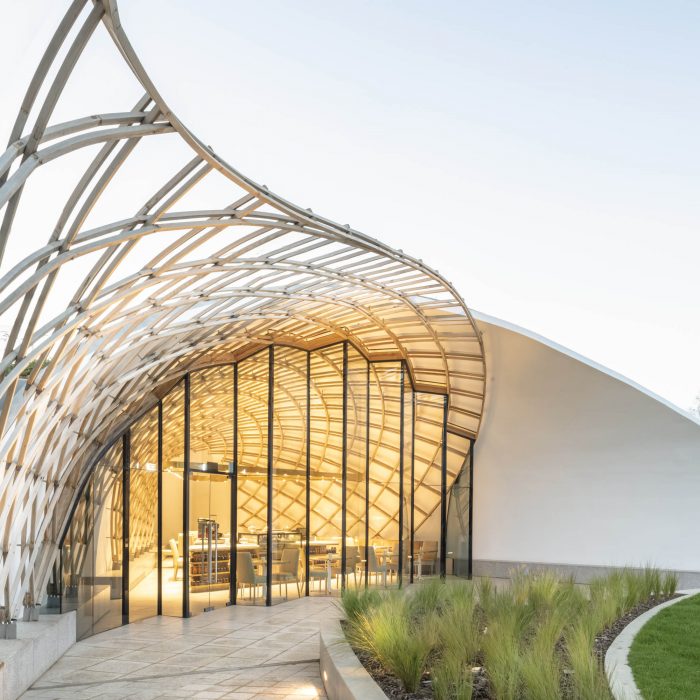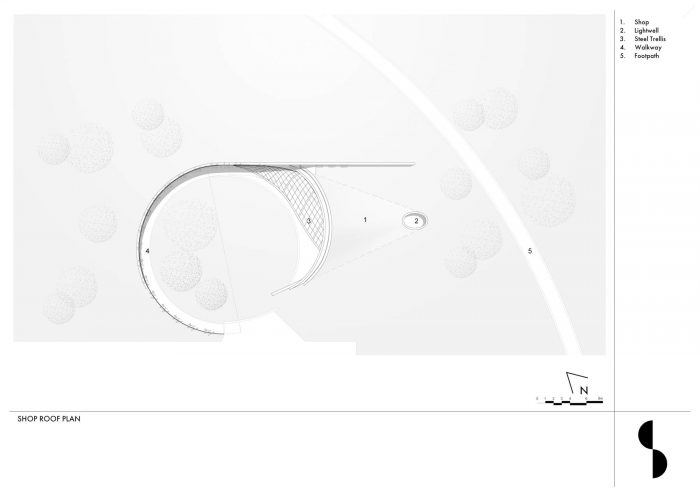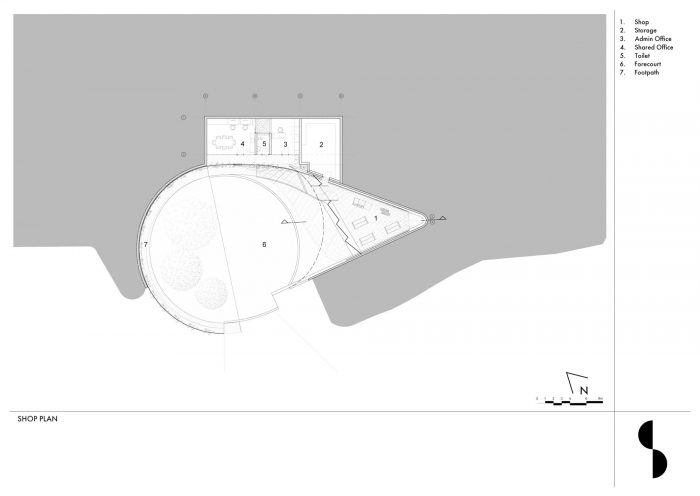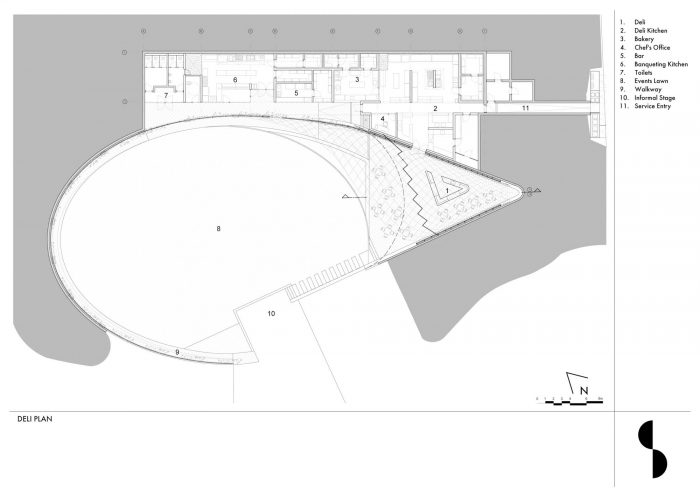总部设在伦敦的建筑师Steyn Studio和Square One景观建筑师事务所南非办事处之间的创造性合作导致了建筑和景观之间毫不费力的融合,花园包裹着新建筑,而新建筑又通过复杂的花架结构交织在一起。这是对南非西开普省Breedekloof山谷丰富的文化历史的微妙庆祝,并从最初居住在山谷的桑人那里获得灵感,他们后来加入了早期的荷兰定居者。
A creative collaboration between London-based architects Steyn Studio and Square One Landscape Architects’ South African office has resulted in the effortless fusion between architecture and landscape, with gardens that wrap over new buildings, which in turn are woven back into the landscape with intricate trellis structures. It’s a subtle celebration of the Breedekloof Valley in South Africa’s Western Cape region’s rich cultural history and draws its inspiration from the San who first inhabited the valley and who were later joined by early Dutch settlers.
客户的要求是,新的开发项目,包括花园、名为 “Die Spens”(茶水间)的小餐馆/咖啡馆和礼品店(”Winkel”),在Bosjes庄园中要有相关性和背景,在庄园的两个主要景点:著名的Bosjes小教堂和庄园之间提供一个诱人和鼓舞人心的旅程,同时不干扰两者之间的视觉对话。
The client’s brief called for the new development, which included gardens, a small restaurant/café called ‘Die Spens’ (The Pantry) and gift shop (‘Winkel’), on the Bosjes Estate to be relevant and contextual, providing an inviting and inspiring journey between the two key attractions on the estate: the well-known Bosjes chapel and the manor house, whilst not interfering with the visual dialogue between the two.
新花园是更广泛的景观的概念性缩影,参考了Breedekloof山谷的农业区域背景。因此,新的说教式花园用迷人的游戏景观来培育土地,鼓励儿童和成人与自然世界以及依偎在其中的建筑接触。通过将湿地和自然水处理系统与森林栖息地和恢复的本土植被结合起来,创造了多样化的生态环境。
The new garden is a conceptual microcosm of the broader landscape, referencing the regional context of the agricultural Breedekloof Valley. The new didactic gardens, therefore, cultivate the land with enchanting playscapes that encourage children and adults to engage with the natural world, and the buildings nestled within it. Diverse ecologies were created by integrating wetlands and natural water treatment systems with forest habitats and rehabilitated indigenous vegetation.
整体设计尊重了庄园中历史悠久的庄园和小教堂的存在,并在视觉上加强了两者之间先前建立的关系,以及周围的葡萄园和山地背景,用新的种植和创建一系列的游行路线来平衡其构成。景观和建筑都经过精心设计,以避免与庄园现有的建筑特征相竞争。它的视觉轮廓很低,植树加强了现有的视觉轴线,景观特征,如树木防风墙,将其重新缝合到周围的农村景观中。
The overall design respectfully acknowledges the presence of the historic manor house and chapel on the estate and visually enhances the previously established relationship between the two, as well as the surrounding vineyards and mountain backdrops, balancing its composition with new planting and the creation of a series of processional routes. The landscaping and buildings were carefully designed so as not to compete with the existing architectural features of the estate. It has a low visual profile with tree planting reinforcing the existing visual axis and landscape features such as tree windbreaks stitching it back into the surrounding rural landscape.
为了隐藏大约750平方米的建筑,我们很早就决定有两个独立的建筑,这也增加了游客的体验。Steyn Studio与Square One紧密合作,不仅将景观中的建筑结构定位为奇观,还将其作为锚点,然后围绕其设计景观。景观元素与建筑结构的无缝整合是项目开始时的一个基本设计目标。景观花园分布在三个倾斜的平台上,由一条弯曲的小路连接,提供通用的通道。两座建筑都有一部分建在斜坡上,屋顶覆盖着土壤,并种植着本地草和多汁植物,与景观完美融合,使全景山景不受影响。
In order to hide approximately 750m2 of building, it was decided early on to have two separate buildings, which also adds to the visitor experience. Steyn Studio worked closely with Square One to not only position the built structures in the landscape as curiosities but also as anchors around which the landscape was then designed. The seamless integration of the landscaping elements with the built structures was an essential design objective from the start of the project. The landscaped gardens are spread across three sloping terraces, connected by a curving pathway that provides universal access. Both buildings are partially built into the slope, the roofs overlaid with soil and planted with indigenous grasses and succulents to blend seamlessly into the landscape, leaving the panoramic mountain views untouched.
建筑物的简单建筑形式的灵感来自于被称为 “Matjieshuis”(Mat House)的桑人的小屋,以及被称为 “KapHuis”(Truss House)的荷兰定居者的第一个住所,这显然是受到了桑人的影响。因此,Kaphuis可能是这两种文化之间的一种混合体。Matjieshuis是一种可移动的、弯曲的、板条框架的结构,上面覆盖着编织的垫子,在前殖民时期和早期殖民时期,桑族牧民带着他们的牛群季节性迁移时使用。KapHuis是一系列覆盖着茅草的A型桁架,内部被降低,以便有更多的头部空间。这两座建筑都是这个历史景观的一部分,与周围环境巧妙地融合在一起。新建筑的土丘与附近的周边山丘有着不可思议的相似之处。
The simple architectural forms of the buildings were inspired by the huts of the San called a ‘Matjieshuis’ (Mat House) as well as the first dwellings of the Dutch settlers, called ‘KapHuis’ (Truss House), which was apparently influenced by the San. The Kaphuis could therefore have been a hybrid of sorts between these two cultures. The Matjieshuis was a portable, curved, slat-framed structure covered with woven mats, used by San herders as they migrated seasonally with their cattle during pre-colonial and early colonial times. The KapHuis was a series of A-frame trusses covered with thatch, with the interior lowered to allow for more headroom. Both structures were part of this historic landscape and blended subtly with their surroundings. The mounds of the new structures have an uncanny resemblance to the nearby surrounding hills.
复杂弯曲的橡木棚架结构,是对桑族小屋的一种微妙的敬意,作为一个视觉焦点,引导游客向内走,然后曲折地创造出咖啡馆/餐厅和礼品店的围墙,然后用新花园 “铺上地毯”。随着时间的推移,这些广泛的棚架将进一步融入到花园中;上面长满了十几种攀援植物。圆锥形的前厅空间部分下沉,以减少其规模影响,而后厅的功能空间则完全在地下。为了让花架图案在室内和室外之间连续出现,玻璃模仿了它的图案,形成了人字形排列,协助玻璃的高大垂直结构跨度。
Intricately curved oak trellis structures, a subtle homage to the San huts, serve as a visual focus that guides visitors inwards and then twists to create the enclosures of the café/restaurant and gift shop which are then ‘carpeted’ over with the new gardens. Over time, these extensive trellises will be further integrated into the garden; overgrown with more than a dozen species of climbing plants. The expressed conical front-of-house spaces are partly sunken to reduce their scale impact, with the functional back-of-house spaces completely underground. In order to allow the trellis pattern to appear continuously weaved between the interior and exterior, the glazing imitates its pattern, resulting in a zig-zag arrangement that assists the tall vertical structural span of the glass.
材料托盘保持简单。面向山体背景的地下建筑元素采用了原始的水泥基饰面。混凝土薄壳拱顶结构被涂成白色,参考了传统的粉刷荷兰角家园的方式,以及附近的小教堂,地板和走道用灰色水磨石装饰。在奥雅纳公司进行了广泛的研究后,就其耐用性和可弯曲性而言,橡木被认为是用于棚架的最佳木材。
The material pallet was kept simple. The underground building elements fronting the mountain backdrop were finished in raw cementitious finishes. The thin concrete shell vaulted structures are painted white, referencing the way traditional whitewashed Cape Dutch homesteads dot the landscape, as well as the nearby chapel, with the floor and walkways finished with grey terrazzo. After extensive research conducted by Arup, oak was considered to be the best timber for the trellis in terms of its durability and bendability.
建筑师: Meyer & Associates Architects, Square One Landscape Architects , Steyn Studio
面积:750 m²
年份:2020年
照片:Dook, David Southwood
设计建筑师:Steyn Studio
项目建筑师: Meyer & Associates Architects Urban Designers
景观设计师:Square One Landscape Architects
家具和装修设计:Liam Mooney Studio
结构工程师:Henry Fagan&Partners
主承包商:GVK-Siya Zama Construction
结构工程师:Grobler & Associates Consulting Engineers
外墙系统:Arup
土木工程师: AVDM Consulting Engineers
电气工程:Bührmann Consulting Engineers
机械工程: Ekcon Consulting Engineers
工料测量师: 2ii Consulting Quantity Surveyors
规划顾问:Tommy Brummer Town Planners
遗产顾问 : Graham Jacobs
城市 : Worcester
国家 : 南非
Architects: Meyer & Associates Architects, Square One Landscape Architects , Steyn Studio
Area: 750 m²
Year: 2020
Photographs: Dook, David Southwood
Design Architect:Steyn Studio
Project Architect:Meyer & Associates Architects Urban Designers
Landscape Architect:Square One Landscape Architects
Furniture& Fit Out Design:Liam Mooney Studio
Gridshell Structural Engineer:Henry Fagan& Partners
Main Contractor :GVK-Siya Zama Construction
Structural Engineer:Grobler & Associates Consulting Engineers
Facade System:Arup
Civil Engineer::AVDM Consulting Engineers
Electrical Engineering:Bührmann Consulting Engineers
Mechanical Engineering:Ekcon Consulting Engineers
Quantity Surveyor::2ii Consulting Quantity Surveyors
Planning Consultants:Tommy Brummer Town Planners
Heritage Consultants:Graham Jacobs
City:Worcester
Country:South Africa

